
Categories
- TRANSMISSION-LINE
- Transmission-Line Fittings
- String Hardware
- Tower Attachment
- Parallel Groove Clamp
- Suspension Clamps
- Tension Clamps
- Compression Joint
- Repair Sleeve
- Preformed Armour Rod
- Stockbridge Damper
- Spacer & Spacer Damper
- Arcing Devices
- Counterweight & Jumper weight
- Danger plate & Number plate
- Corona & Grading Rings
- Transmission Conductor
- All aluminium stranded conductors(AAC)
- Aluminium conductors steel reinforced(ACSR)
- All aluminium alloy conductors(AAAC)
- Aluminium alloy conductors steel reinforced(AACSR)
- Arial Earth Wire & Shield Wire & Galvanized Steel Wire
- Porcelain Disc Suspension Insulators
- Composite Long Rod Insulators
- Toughened Glass Disc Insulator
- Tower of Transmission-Line
- SUBSTATION
- Connector and Fittings for Tubular Busbar
- Tubular Busbar Palm(Welding)
- Busbar A-Frame
- Connector for Tubular Busbar
- Tubular Busbar Support
- Tubular Busbar Earthing
- Tubular Busbar End Caps & Balls
- Substation Insulators
- Solid Porcelain Post Insulators(66kV -500kV)
- Solid Polymer Post Insulators(66kV-500kV)
- Hollow Core Insulators for Voltage Transformer
- Hollow Core Insulators for Capacitor
- Porcelain Disc Insualtors
- Polymer Long Rod Insulators
- Glass Disc Insulators
- Busbar
- Tubular Copper Busbar
- Rectangular Aluminum Busbar
- Rectangular Copper Busbar
- Tubular Aluminum Busbar
- Terminations & Connections for Conductor
- Aluminium Flexible Connector
- Copper Flexible Connector(Flat Braid)
- Compression Run Compression T Clamp(Closed)
- Compression Run Compression T Clamp(Open)
- Compression Run Palm Tap(Closed)
- Compression Run Palm Tap(Open)
- Compression Terminal Clamp
- Twin Conductor Compression Terminal Clamp
- Straight Bolted Type Terminal Clamp
- 90° Bolted Type Terminal Clamp
- Straight Twin Conductor Bolted Type Terminal Clamp
- 90° Twin Conductor Bolted Type Terminal Clamp
- Twin Conductor Bolted Type Tee Clamp
- Twin Conductor Run Palm Tap Lengthways Terminal Clamp
- Twin Conductor Run Palm Tap Transverse Terminal Clamp
- Parallel Groove Clamp
- Straight Connector Conductor to Conductor
- Tee Connector Conductor to Conductor
- Adaptor Plates
- Straight Type
- Right Angle Horizontal Type
- Right Angle Vertical Type
- Bi-Metallic Transition Plate
- Spacers
- Galvanized & Stainless Steel Bolts Assemblies
- Strings Fittings
- Connections for Flat Busbar
- Gantries & Structure
- Distribution Conductor
- All Aluminium Stranded Conductors(AAC)
- All Aluminium Alloy Conductors(AAAC)
- Substation Parallel Spacer Triple
- DISTRIBUTION
- Preformed Fittings
- Armor-Grip Suspension Clamp
- Trunnion Armor-Grip Clamp
- Aluminum Alloy Dead-Ends
- Copper Alloy Dead-End
- Thimbles
- Top Ties
- Armored Rod Twin Ties
- Side & Spool Ties
- Parrot Bill End Aluminum Alloy Armor Rods
- Copper Alloy Armor Rods
- Galvanized Steel Armor Rods
- Aluminium Alloy Line Splice
- Copper Alloy Line Splices
- Galvanized Steel Line Splices
- Aluminium Alloy Full Tension Line Splice
- T-Connector
- Helical Arcing Horn
- Galvanized Steel Guy-Grip
- Pole Top Make Off
- Insulated Stay
- Double-Wrap Guy-Grip
- Spiral Vibration Damper High Impact PVC
- Lashing Rods
- PVC Spacer
- The Pole Line Hardware
- Cross Arms
- Fastenes Bolts & Nuts
- Thimble Bolt Rod & Eye Bolt
- Eye Nuts
- Clevis
- Insulation Pin & Studs & Spindles
- Pole Hoop
- Cable & Conductor
- ACSR
- AAC
- ABC Cable
- SAC Cable
- Distribution Insulators
- Porcelain Disc Insualtors
- Polymer Long Rod Insulators
- Glass Disc Insulators
- Porcelain Line Post Insulators(Vertical)
- Porcelain Line Post Insulators(Horizontal)
- Polymer Line Post Insulators(Vertical)
- Polymer Line Post Insulators(Horizontal)
- Porcelain Pin Insulator(BS standard)
- Porcelain Pin Insulator(ANSI standard)
- Polymer Pin Insulators
- Shackle Insulators
- Spool Insulators
- Stay Insulators
- Wiring Insulators
- Telephone Lines Insulators
- Guy Strain Insulators
- Spindle for insulators
- BS Spindle for Pin Insulators
- ANSI Spindle for Pin Insulators
- Normal Short Spindle for Line Post Insulators
- Rachet short spindle for line post insulators
- Rachet long spindle for line post insulators
- Fuse/fuse cutout
- Porcelain Fuse Cutout
- Composite Fuse Cutout
- K Type Fuse Link
- HRC Fuse
- J Type Fuse
- Disconnect Switch
- Surge Arrestor 11-36kV(5kA-10kA)
- Over head Line fittings
- Suspension Clamp
- Bolt Type Tensioning Clamp
- U-Bolts
- Shackle
- Ball Eye
- Socket Tongue
- Arcing Horn
- UT Connectors
- ABC fittings
- Copper Strand Wire and Braid Connector
- Insulation Piercing Connector(IPC)
- Fire-Retardant IPC
- T connecting Terminal
- Insulation Piercing Grounding Connectors
- Fuse Bace
- Wedged Insulation Strain Clamp
- Suspension Clamp for ABC cable
- Suspension Clamp with Aluminum Bracket
- Anchoring Clamp
- Metal Anchor Clamp
- Four-Core Tension Clamp
- Pre-Insulated Sleeve
- Pre-Insulated Bimetal Sleave
- Expansion Screws
- JXL Series Clamp(Wedge Type)
- Parallel Groove Clamp with Insulator Cover
- SAC fittings
- Anti Sway Bracket for HDPE Spacer
- Tangent Support Bracket
- HT Tape for SAC Cable
- Cable lug
- Copper Cable Lugs-DT
- Double Holes Copper Cable lugs-DT2
- Aluminum Cable Lugs-DL
- Double holes Aluminum Cable lugs-DL2
- Bi-Metal Cable Lugs-DTL
- Copper Aluminum Cable lugs-CAL-A
- Copper Aluminum Cable lugs-CAL-B
- Copper Aluminum Cable lugs-European style
- Copper Aluminum Cable lugs-For cable tap box
- Copper Cable Lugs-OT
- P.G. Clamp & Connector
- Copper Parallel Groove Clamp-CAPG
- Aluminum Parallel Groove Clamp-CAPG
- Copper Parallel Groove Clamp
- Aluminum Parallel Groove Clamp-JB
- Copper-Aluminum Parallel Groove Clamp-CAPG(Hard-Solder)
- Copper-Aluminum Parallel Groove Clamp-CAPG( Friction Welding)
- C Clamp-Copper
- C Clamp-Aluminum
- Connecting Clamp-Aluminum
- Connecting Clamp-Copper
- Connecting Clamp (Hard-Solder)
- Connecting Clamp (Friction Welding)
- Connecting Tube-Aluminum
- Connecting Tube-Copper
- Connecting Tube-Bimetal
- Copper Plate
- Aluminum Plate
- Bimetal Plate
- Copper-Aluminum Parallel Groove Clamp( Friction Welding)
- Stay complete set
- Eye Bolts
- Turn Buckle
- Thimble
- Stay Grip
- Stay Wire
- Adjustable Stay Rod
- Non Adjustable Stay Rod
- Stay Anchor Plate/Earth Plate
- Other accessory
- Stainless Steel with Retaining Buckle
- Cable Nail
- Insulation Tape
- Stainless Steel Strip
- Aluminium Insulated Tie Wire
- COMMUNICATION
- Dead-End for OPGW
- Single Suspension Set
- Double Suspension Set
- Vibration Damper
- Armour Rods for Vibration Damper
- Ground Wire Set
- Joint Box
- Cable Tray
- Spiral Vibration Damper
- Corona Coil
- Downlead
- Downlead
- Fastened Fittings for Pole
- Fastened Fittings for Pole
- Fastened Fittings for Twoer
- Fastened Fittings for Twoer
- Fastened Fittings for Twoer
- GROUNDING SYSTEM
- Earth Rod
- Solid Stainless Steel Earth Rods
- Solid Copper Earth Rods
- Copper Clad Steel Earth Rods
- H.D.G Steel Earth Rods
- Earthing Wire
- Copper Wire
- PVC Covered Copper Wire
- Flexible Copper Braid
- Copper Clad Steel Wire
- Fittings for Earth Rod
- Fittings for Threaded Earth Rod
- Fittings for Unthreaded Earth Rods
- Earth Tube
- Conductor Tape
- Copper Tape
- Tinned Copper Tape
- PVC Insulated Copper Tape
- Stainless Steel Tape
- Aluminum Tape
- Bentonite
- Concrete Earth Pits
- Connectors
- C connectors
- Tinned Copper Flexible Connector
- Tape Clip
- Tape Clamp
- Rod to Tape Clamp
- Rod to Cable Clamp
- U-Bolt Rod Clamp
- Earth Points
- Earth Plates
- Solid Copper Earth Plates
- Lattice Copper Earth Plates
- Earth Bars & Disconnector Links
- Exothermic Welding
- Exothermic Powder
- Tooling Box
- Exothermic Welding Mould
- Marconite
- INSULATOR FITTINGS
- Clevis Fittings
- Y-Clevis Fittings
- Tongue Fittings
- Socket Fittings
- Ball Fittings
- Eye Fittings
- For Line Post Insulator
- For Cross-Arm Composite Insulator
- For Pin Insulator
- For Railway Insulator
- For Clamp (Vertical)
- For Clamp (Horizontal)
- Ball Pin & Socket Cap
- Tongue Pin & Clevis Cap
- For Others
- Top Head Fitting for Line Post Insulator
- Top Head Fitting Clevis for Line Post Insulator
- Top Head fitting Tongue for Line Post Insulator
- POWER CONSTRUCTION TOOLS
- Galvanized Steel Antitwist Wire Rope
- Hydraulic Press
- Hand Hydraulic Crimping Tools
- Cable Cutter
- Tube Terminal Crimping Tools
- Mechanical Cable Cutter
- Wire Grip
- Hand Puller
- Snactch Block
- Stringing Block
- Cable Wellhead Pulley
- Cable Orifice Protection Pulleys
- High Voltage Operating Rod/Hot Stick
- H.V. Earthing Wire and Rod
- Security Clamp
- Wood Pole Climber
- Grounding Clamp
- Hot Line Cable Clamp
- Swivel Joints
- Elelctro Scope
- OEM/ODM
- SOLAR

Cable lug
Cable lug
-
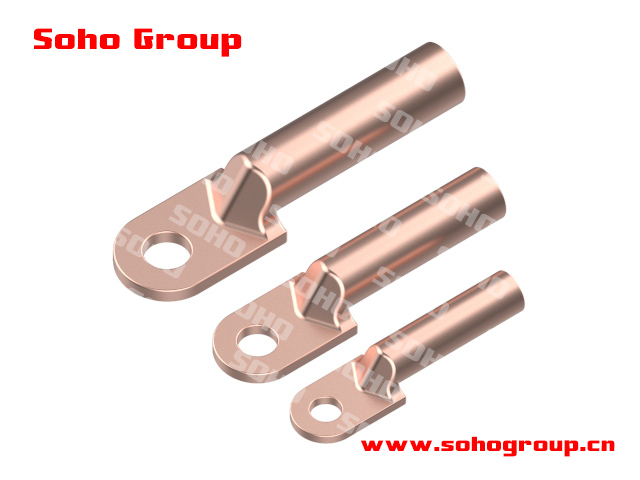 Copper Cable Lugs-DT
Copper Cable Lugs-DTMaterial: Copper cable lugs are made of high-conductivity copper or copper alloy, which is an excellent conductor of electricity. This material ensures low electrical resistance and efficient electrical transfer.
Types: Copper cable lugs come in various types, including ring lugs, spade lugs, pin lugs, and butt splice lugs, each designed for specific applications and connection methods.
Sizing: Copper cable lugs are available in a wide range of sizes to accommodate different conductor diameters and configurations. Proper sizing is crucial to ensure a secure and reliable connection.
Termination: The lugs are typically crimped or soldered onto the copper conductor. Crimping involves using a specialized crimping tool to compress the lug onto the conductor, creating a secure and gas-tight connection.
-
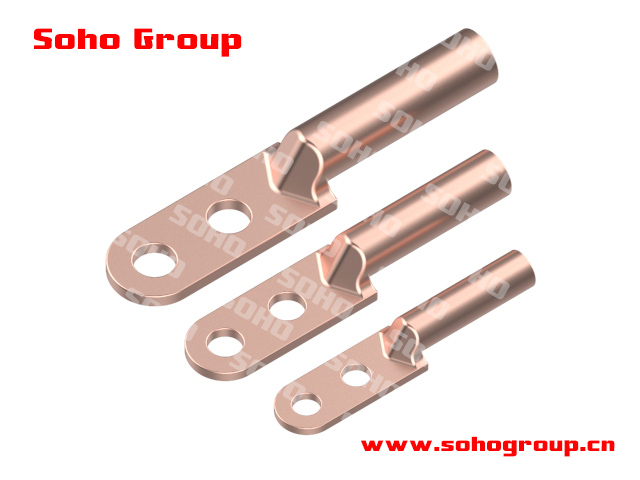 Double Holes Copper Cable lugs-DT2
Double Holes Copper Cable lugs-DT2● Material: Copper cable lugs are made of high-conductivity copper or copper alloy, which is an excellent conductor of electricity. This material ensures low electrical resistance and efficient electrical transfer.
● Types: Copper cable lugs come in various types, including ring lugs, spade lugs, pin lugs, and butt splice lugs, each designed for specific applications and connection methods.
● Sizing: Copper cable lugs are available in a wide range of sizes to accommodate different conductor diameters and configurations. Proper sizing is crucial to ensure a secure and reliable connection.
● Termination: The lugs are typically crimped or soldered onto the copper conductor. Crimping involves using a specialized crimping tool to compress the lug onto the conductor, creating a secure and gas-tight connection.
-
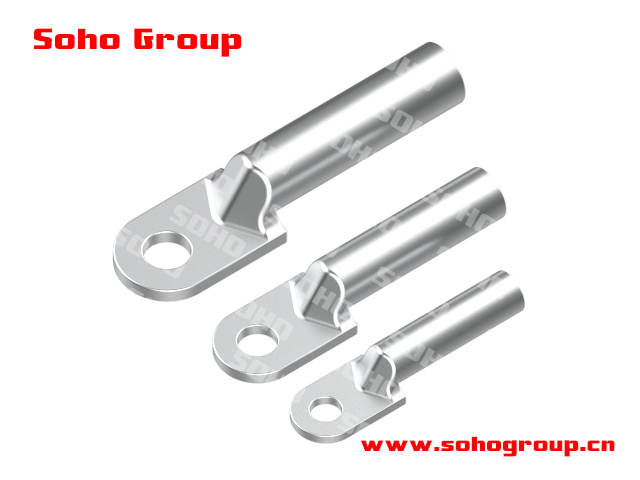 Aluminum Cable Lugs-DL
Aluminum Cable Lugs-DL● Material: Aluminum cable lugs are made from high-quality aluminum or aluminum alloy, which is chosen for its excellent electrical conductivity, lightweight properties, and resistance to corrosion.
● Types: Aluminum cable lugs come in various types and styles, including ring lugs, spade lugs, pin lugs, and butt splice lugs, each designed for specific applications and connection methods.
● Sizing: They are available in various sizes to accommodate different conductor diameters and configurations, ensuring a proper and secure connection.
● Termination: Similar to copper cable lugs, aluminum cable lugs are typically crimped onto the aluminum conductor using a specialized crimping tool. The crimping process involves applying mechanical pressure to create a gas-tight connection.
-
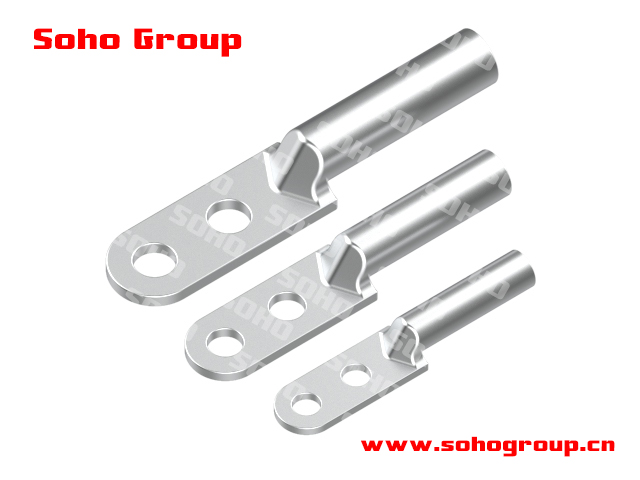 Double holes Aluminum Cable lugs-DL2
Double holes Aluminum Cable lugs-DL2● Material: Aluminum cable lugs are made from high-quality aluminum or aluminum alloy, which is chosen for its excellent electrical conductivity, lightweight properties, and resistance to corrosion.
● Types: Aluminum cable lugs come in various types and styles, including ring lugs, spade lugs, pin lugs, and butt splice lugs, each designed for specific applications and connection methods.
● Sizing: They are available in various sizes to accommodate different conductor diameters and configurations, ensuring a proper and secure connection.
● Termination: Similar to copper cable lugs, aluminum cable lugs are typically crimped onto the aluminum conductor using a specialized crimping tool. The crimping process involves applying mechanical pressure to create a gas-tight connection.
-
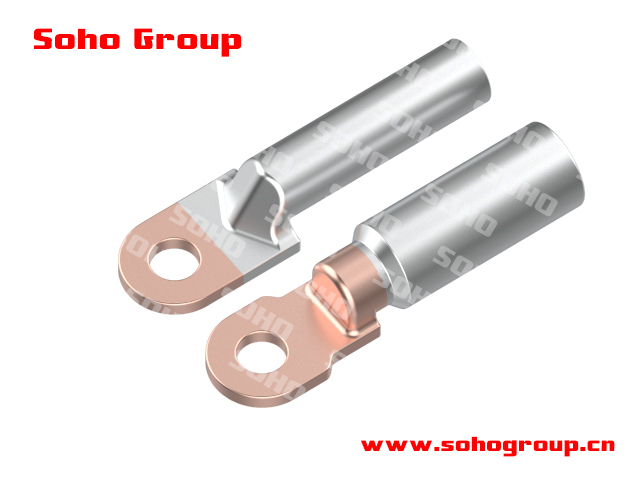 Bi-Metal Cable Lugs-DTL
Bi-Metal Cable Lugs-DTL● Bimetallic Construction: Bi-metal cable lugs are constructed with two different metals, usually copper and aluminum, joined together. The copper part is designed to make a secure connection with copper conductors, while the aluminum part is designed to connect to aluminum conductors.
● Types: Bi-metal cable lugs come in various types and configurations to accommodate specific applications. They may include compression-type lugs, bolted lugs, or other connection methods.
● Transition: These lugs allow for a smooth and secure transition between copper and aluminum conductors without the risk of galvanic corrosion. This is important because copper and aluminum have different electrical and mechanical properties.
● Termination: They can be crimped or bolted onto the respective copper and aluminum conductors. Crimping ensures a gas-tight and reliable connection, while bolting provides a mechanical connection.
-
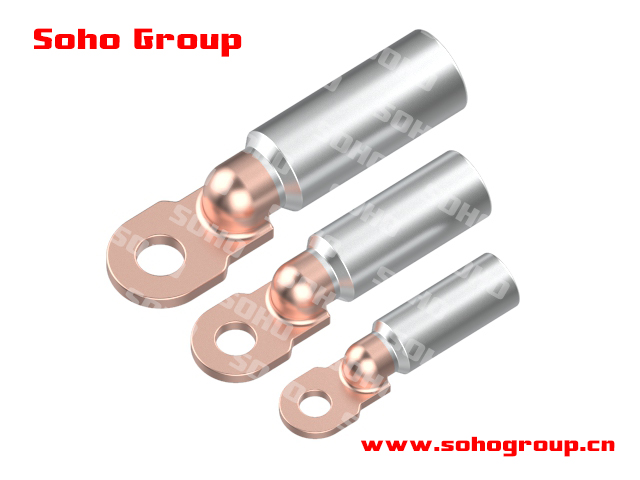 Copper Aluminum Cable lugs-CAL-A
Copper Aluminum Cable lugs-CAL-A● Bimetallic Construction: Bi-metal cable lugs are constructed with two different metals, usually copper and aluminum, joined together. The copper part is designed to make a secure connection with copper conductors, while the aluminum part is designed to connect to aluminum conductors.
● Types: Bi-metal cable lugs come in various types and configurations to accommodate specific applications. They may include compression-type lugs, bolted lugs, or other connection methods.
● Transition: These lugs allow for a smooth and secure transition between copper and aluminum conductors without the risk of galvanic corrosion. This is important because copper and aluminum have different electrical and mechanical properties.
● Termination: They can be crimped or bolted onto the respective copper and aluminum conductors. Crimping ensures a gas-tight and reliable connection, while bolting provides a mechanical connection.
-
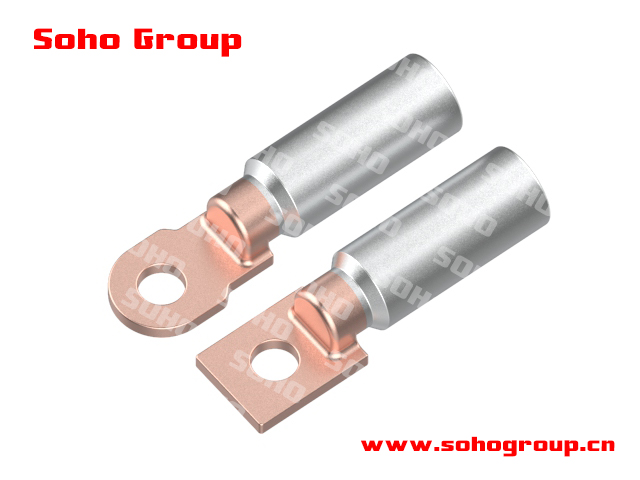 Copper Aluminum Cable lugs-CAL-B
Copper Aluminum Cable lugs-CAL-B● Bimetallic Construction: Bi-metal cable lugs are constructed with two different metals, usually copper and aluminum, joined together. The copper part is designed to make a secure connection with copper conductors, while the aluminum part is designed to connect to aluminum conductors.
● Types: Bi-metal cable lugs come in various types and configurations to accommodate specific applications. They may include compression-type lugs, bolted lugs, or other connection methods.
● Transition: These lugs allow for a smooth and secure transition between copper and aluminum conductors without the risk of galvanic corrosion. This is important because copper and aluminum have different electrical and mechanical properties.
● Termination: They can be crimped or bolted onto the respective copper and aluminum conductors. Crimping ensures a gas-tight and reliable connection, while bolting provides a mechanical connection.
-
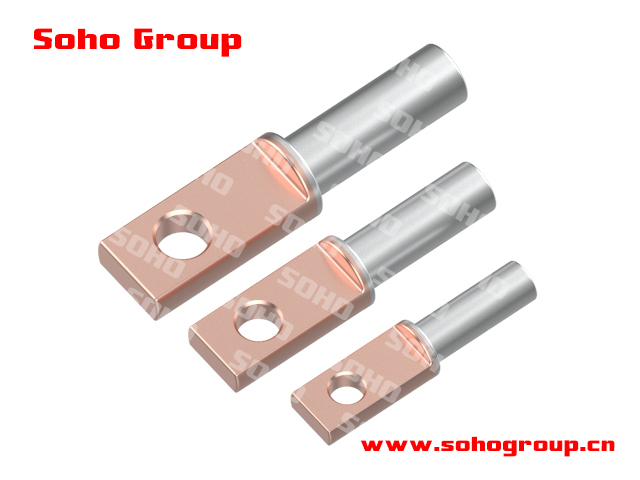 Copper Aluminum Cable lugs-European style
Copper Aluminum Cable lugs-European style● Bimetallic Construction: Bi-metal cable lugs are constructed with two different metals, usually copper and aluminum, joined together. The copper part is designed to make a secure connection with copper conductors, while the aluminum part is designed to connect to aluminum conductors.
● Types: Bi-metal cable lugs come in various types and configurations to accommodate specific applications. They may include compression-type lugs, bolted lugs, or other connection methods.
● Transition: These lugs allow for a smooth and secure transition between copper and aluminum conductors without the risk of galvanic corrosion. This is important because copper and aluminum have different electrical and mechanical properties.
● Termination: They can be crimped or bolted onto the respective copper and aluminum conductors. Crimping ensures a gas-tight and reliable connection, while bolting provides a mechanical connection.
-
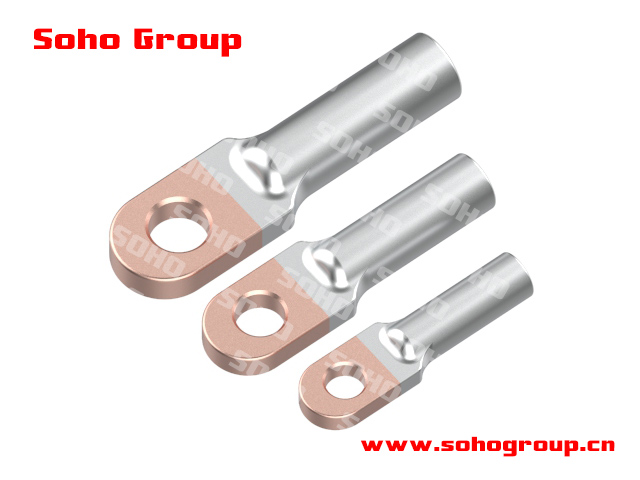 Copper Aluminum Cable lugs-For cable tap box
Copper Aluminum Cable lugs-For cable tap box● Bimetallic Construction: Bi-metal cable lugs are constructed with two different metals, usually copper and aluminum, joined together. The copper part is designed to make a secure connection with copper conductors, while the aluminum part is designed to connect to aluminum conductors.
● Types: Bi-metal cable lugs come in various types and configurations to accommodate specific applications. They may include compression-type lugs, bolted lugs, or other connection methods.
● Transition: These lugs allow for a smooth and secure transition between copper and aluminum conductors without the risk of galvanic corrosion. This is important because copper and aluminum have different electrical and mechanical properties.
● Termination: They can be crimped or bolted onto the respective copper and aluminum conductors. Crimping ensures a gas-tight and reliable connection, while bolting provides a mechanical connection.
-
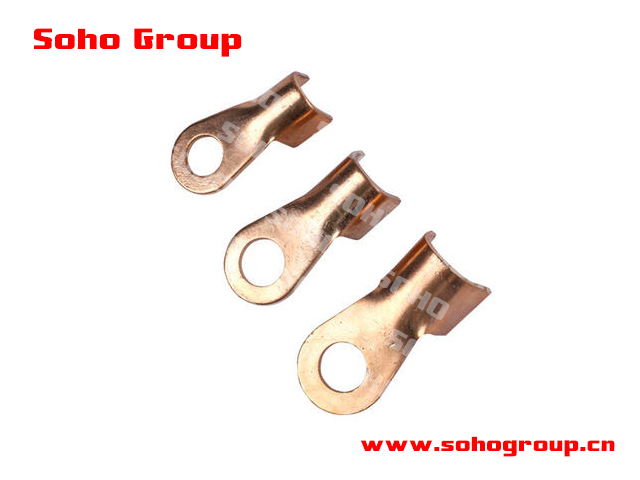 Copper Cable Lugs-OT
Copper Cable Lugs-OT● Material: Copper cable lugs marked as "OT" are made from high-conductivity copper or copper alloy, which provides excellent electrical conductivity and mechanical strength.
● Types: Copper cable lugs are available in various types, including ring lugs, spade lugs, pin lugs, and butt splice lugs, each designed for specific applications and connection methods.
● Sizing: They come in different sizes, with the "OT" marking typically indicating the lug's size or wire capacity, ensuring compatibility with a range of conductor diameters.
● Termination: Copper cable lugs are typically crimped onto the copper conductor using a specialized crimping tool. The crimping process involves applying mechanical pressure to create a gas-tight connection.
Sorry, no matches were found in Products for Cable lug.
Want to get the matched products and detailed quotations?







 +86-25-58065309
+86-25-58065309
 www.sohogroup.cn
www.sohogroup.cn Daqiao Industry Park, Yangzhou City,
Daqiao Industry Park, Yangzhou City,